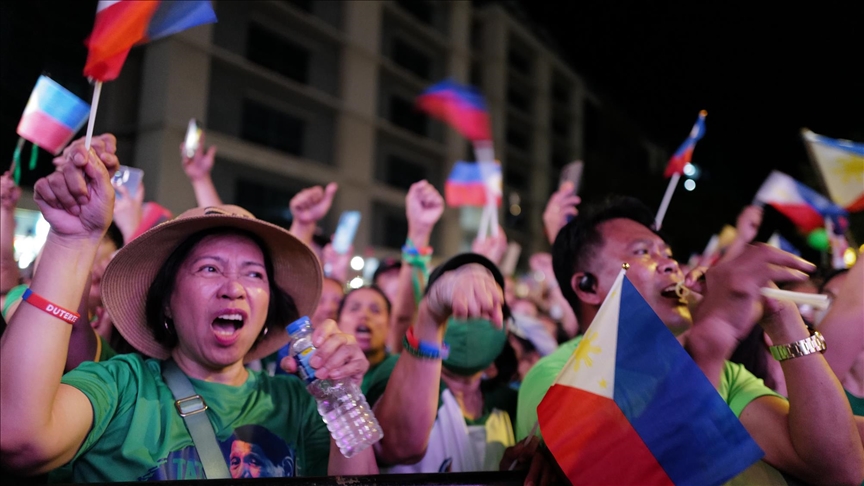‘Culture of corruption’ protests: What’s ahead for Philippines?
Tens of thousands of Filipinos recently took to the streets for the country’s largest anti-corruption protests in years

- Analysts say the protests fueled by graft and climate concerns were not directed at the government of President Marcos, who himself revealed the scandal in a July address to parliament
- Filipinos know that dealing with the climate vulnerability of the archipelagic nation ‘demands capable institutions and many see strong weaknesses in this regard,’ says International Crisis Group analyst Georgi Engelbrecht
ISTANBUL
Tens of thousands of Filipinos flooded the streets last Sunday, condemning what they see as a deeply entrenched “culture of corruption” after revelations of a massive fraud in nearly 10,000 flood-control projects – a major concern in the climate-vulnerable archipelagic country.
The demonstrations, which left one person dead and more than 200 arrested, marked the country’s largest anti-graft mobilization in years – and analysts say their outcome could reshape the fragile balance between the nation’s rival political dynasties.
“This protest is not per se against (President Ferdinand) Marcos Jr. but the culture of corruption,” Georgi Engelbrecht, senior analyst for the Philippines at the International Crisis Group, told Anadolu.
“For a long time, Filipinos knew this was an open secret that bureaucrats and local officials take kickbacks for certain projects. What made these protests so relevant is that they happened at a time when the Philippines is being confronted by the climate crisis.”
The public anger stems from the discovery of large-scale fraud in 9,855 government flood-control projects, worth more than 545 billion pesos ($9.5 billion). Protesters have demanded accountability, calling on officials to disclose their assets, liabilities, and net worth.
President Marcos, who himself revealed the scandal in his July address to parliament, said he understood the outrage. “Since this has all been exposed … to the general public, do you blame them for going out on the streets?” he said.
“If I weren’t president, I might be out on the streets with them,” he added, while urging demonstrators to remain peaceful and ordering police to exercise “maximum tolerance.”
Climate anxiety fueling public fears
The Philippines, an archipelago of more than 7,000 islands, lies within the Pacific Typhoon Belt and faces an average of 20 tropical cyclones each year.
The failure of vital flood-protection projects – exposed as “ghost infrastructure” – is seen as a betrayal in a country that regularly suffers deadly storms and widespread flooding.
In 2013, Typhoon Haiyan battered the country with heavy rainfall, powerful winds and storm surges, claiming around 6,300 lives, making it the deadliest such disaster on record. That came just a year after Typhoon Bopha killed more than 1,900 people, while more recent ones such as Typhoon Mangkhut in 2018 have claimed hundreds more lives and collectively caused losses running in billions of dollars.
Analyst Engelbrecht noted that the corruption allegations strike at the heart of climate resilience, especially given the current threat of Typhoon Ragasa, which has impacted several countries in the region, from China to the Philippines.
“Typhoons have been hitting the country, and when some officials were exposed, it really made a lot of people angry,” he said.
“Dealing with this crisis demands capable institutions. And many Filipinos see strong weaknesses in this regard.”
Political fallout
The fallout has already claimed high-level resignations.
House Speaker Martin Romualdez, a cousin of the president, and Senate President Chiz Escudero stepped down amid investigations into the scandal.
Engelbrecht reiterated that the protests were “a larger expression of discontent,” adding that the movement united groups ranging from leftist activists to centrist parties and supporters of former President Rodrigo Duterte.
Still, some demonstrators avoided direct calls for Marcos’ resignation, fearing it could empower Duterte’s camp, he said.
Once electoral allies, the Marcos and Duterte dynasties have since turned into bitter rivals.
Sara Duterte resigned from Marcos’ Cabinet last year but remains the vice president, while her father now sits in detention in The Hague under International Criminal Court charges linked to his drug war.
Opposition lawmaker Renee Louise Co said protesters aimed their anger at both dynasties. “It’s no secret that the two camps are bitterly throwing mud at each other so that one can emerge as the more popular figure,” she told Anadolu. “But on our part, we don’t want to take either side. We’re actually condemning both sides.”
Analysts warn that uncertainty hangs over the political scene at the moment, as the protests spotlighting longstanding governance failures could shape the run-up to the 2028 elections.
“So, right now, the key questions are: Will the protests continue, and how will the Marcos camp, the Duterte camp and the various forces from the middle ground deal with the situation?” Engelbrecht said.
For now, whether these demonstrations herald deeper change, or stay limited to another flare-up in the Philippines’ political history, remains to be seen.
Anadolu Agency website contains only a portion of the news stories offered to subscribers in the AA News Broadcasting System (HAS), and in summarized form. Please contact us for subscription options.







